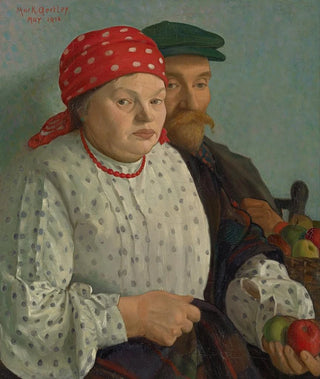Art print | The apple woman and her husband - Mark Gertler


View from behind

Frame (optional)
In the vibrant world of modern art, "The Apple Woman and Her Husband" by Mark Gertler stands out for its boldness and emotional depth. This iconic artwork, created in 1916, illustrates the fusion between figurative representation and abstraction, while offering a fascinating glimpse into couple dynamics through the lens of modernity. The vibrant composition, where shapes and colors intertwine, evokes palpable intimacy, while leaving room for each viewer's personal interpretation. Gertler, with his keen sense of observation, manages to capture not only the appearance of his subjects but also the very essence of their relationship, making this work of art evocative and powerful.
Style and uniqueness of the work
Mark Gertler's style is often characterized by a bold palette and stylized forms, and "The Apple Woman and Her Husband" is no exception. The artwork is distinguished by its vivid colors and defined contours, creating a striking contrast between the human figures and their environment. The woman, symbolically represented by an apple, embodies fertility and sensuality, while her husband, in the background, appears both protective and distant. This duality is reinforced by the use of geometric motifs that structure the composition, giving the entire piece a captivating visual rhythm. Gertler does not limit himself to simple representation; he explores human relationships in all their complexity, inviting the viewer to contemplate the nuances of love and commitment.
The artist and his influence
Mark Gertler, a central figure of the British artistic movement of the early 20th century, made his mark with his innovative approach and commitment to social themes. Influenced by cubism and fauvism, he integrated these currents into a style that is uniquely his own, blending modernity and tradition. Gertler was also an active member of the Bloomsbury group, where he mingled with other influential artists and thinkers, enriching his artistic vision. His work, although often tinged with melancholy, bears witness to a keen sensitivity to the realities of

Matte finish

View from behind

Frame (optional)
In the vibrant world of modern art, "The Apple Woman and Her Husband" by Mark Gertler stands out for its boldness and emotional depth. This iconic artwork, created in 1916, illustrates the fusion between figurative representation and abstraction, while offering a fascinating glimpse into couple dynamics through the lens of modernity. The vibrant composition, where shapes and colors intertwine, evokes palpable intimacy, while leaving room for each viewer's personal interpretation. Gertler, with his keen sense of observation, manages to capture not only the appearance of his subjects but also the very essence of their relationship, making this work of art evocative and powerful.
Style and uniqueness of the work
Mark Gertler's style is often characterized by a bold palette and stylized forms, and "The Apple Woman and Her Husband" is no exception. The artwork is distinguished by its vivid colors and defined contours, creating a striking contrast between the human figures and their environment. The woman, symbolically represented by an apple, embodies fertility and sensuality, while her husband, in the background, appears both protective and distant. This duality is reinforced by the use of geometric motifs that structure the composition, giving the entire piece a captivating visual rhythm. Gertler does not limit himself to simple representation; he explores human relationships in all their complexity, inviting the viewer to contemplate the nuances of love and commitment.
The artist and his influence
Mark Gertler, a central figure of the British artistic movement of the early 20th century, made his mark with his innovative approach and commitment to social themes. Influenced by cubism and fauvism, he integrated these currents into a style that is uniquely his own, blending modernity and tradition. Gertler was also an active member of the Bloomsbury group, where he mingled with other influential artists and thinkers, enriching his artistic vision. His work, although often tinged with melancholy, bears witness to a keen sensitivity to the realities of






